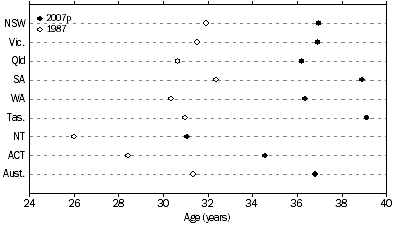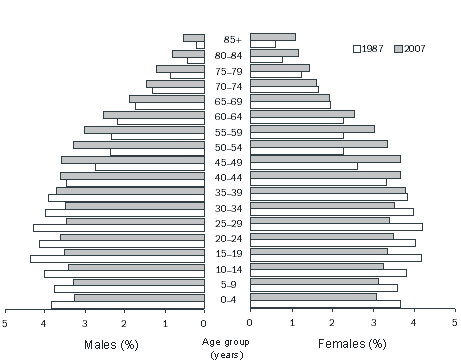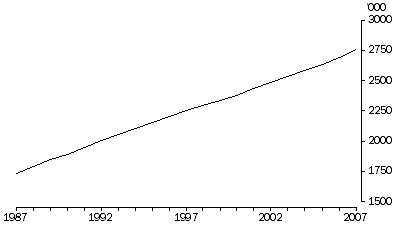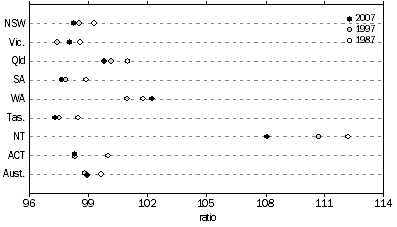NOTES
ABOUT THIS PUBLICATION
This issue contains estimates of the resident population of Australian states and territories as at 30 June of each reference year. Estimates up to 2001 are final, estimates between 2002 and 2006 are revised using results of the 2006 Census of Population and Housing, and 2007 estimates are preliminary. For more information on rebasing population estimates over the 2001-2006 intercensal period, see Feature Article Preliminary Rebasing and Component Revision Cycles of Australia's Population Estimates in Australian Demographic Statistics, March Quarter 2007 (cat. no. 3101.0).
The next issue of this publication and accompanying spreadsheets to be released in June 2008 will contain final rebased data for 30 June 2002 to 30 June 2006.
In recognition of the inherent inaccuracy involved in population estimation, population figures over 1,000 in the text are rounded to the nearest hundred, and figures less than 1,000 are rounded to the nearest ten. While unrounded figures are provided in tables, accuracy to the last digit is not claimed and should not be assumed.
It is recommended that the relevant statistics be rounded by users for commentary based on the statistics in this publication. All data are affected by errors in reporting and processing. No reliance should be placed on statistics with small values.
INQUIRIES
For further information about these and related statistics, contact the National Information and Referral Service on 1300 135 070 or Caroline Hartnett on Canberra (02) 6252 6098.
SUMMARY COMMENTARY
INTRODUCTION
In the 12 months to 30 June 2007, the Australian population increased by 315,700 people, reaching 21,017,200. The annual growth rate for the year ended 30 June 2007 (1.5%) was slightly higher than that recorded for the year ended 30 June 2006.
AGEING POPULATION
Australia's population, like that of most developed countries, is ageing as a result of sustained low fertility and increasing life expectancy. This is resulting in proportionally fewer children (under 15 years of age) in the population. The median age (the age at which half the population is older and half is younger) of the Australian population has increased by 5.5 years over the last two decades, from 31.3 years at 30 June 1987 to 36.8 years at 30 June 2007. Between 30 June 2006 and 2007 the median age increased by 0.2 years. Over the next several decades, population ageing is expected to have significant implications for Australia including health, labour force participation, housing and demand for skilled labour (Productivity Commission 2005, Economic Implications of an Ageing Australia, Research Report, Canberra).
STATES AND TERRITORIES
At 30 June 2007, Tasmania had the oldest population of all the states and territories with a median age of 39.1 years. The second oldest was South Australia with a median age of 38.9 years, followed by New South Wales (37.0 years), Victoria (36.9 years), Western Australia (36.4 years), Queensland (36.2 years), the Australian Capital Territory (34.6 years) and the Northern Territory (31.1 years).
Median Age of population - At 30 June

Tasmania experienced the largest increase in median age over the last 20 years, increasing by 8.1 years from 31.0 years in 1987 to 39.1 years in 2007. The emigration of younger adults from Tasmania to the Australian mainland has contributed to this accelerated ageing, see
Migration, Australia, 2005-06 (cat. no. 3412.0).
Population change, Age group
- 1987 to 2007p

Between 30 June 1987 and 30 June 2007, the proportion of Australia's population aged 15-64 years has remained relatively stable, increasing from 66.6% to 67.5% of the total population. The proportion of people aged 65 years and over has increased from 10.7% to 13.1%. During the same period, the proportion of population aged 85 years and over has doubled from 0.8% of the population at 30 June 1987 to 1.6% of the total population at 30 June 2007. The proportion aged under 15 years decreased from 22.7% to 19.4%.
Population structure, Age and sex
- Australia
- 1987 and 2007p

MODAL AGE
The age with the greatest number of people in Australia at 30 June 2007 was 36 years with 327,700 people. This corresponds to children born during the baby boom echo in the early 1970s. However, the modal age for the Australian Capital Territory is 24 and 25 years with 6,100 people each, which corresponds to migration of younger adults to Canberra for education and employment.
CHILDREN (UNDER 15 YEARS OF AGE)
The number of children aged 0-14 years in the population increased by 23,500 in the 12 months to 30 June 2007. The number of children aged 0-4 increased by 21,900, 5-9 increased by 1,200 and 10-14 increased by 420. While fertility rates and the number of births have increased in recent years, this does not impact on the number of children in older ages of 5-14 years.
In the year ended 30 June 2007, Western Australia recorded the largest percentage increase (1.6%) in the number of children aged 0-14 years. Queensland also recorded a positive growth of 1.2%, as did the Australian Capital Territory, Victoria and the Northern Territory which recorded increases of 0.9%, 0.6% and 0.4% respectively. New South Wales and Tasmania have remained relatively stable with changes of less than 0.1% to the population aged 0-14 years.
Between 30 June 1987 and 30 June 2007, the proportion of population aged 0-14 years decreased by 3.3 percentage points from 22.7% to 19.4%.
WORKING AGE POPULATION (AGED 15-64 YEARS)
The number of people aged 15-64 years (working age population) increased by 1.6% (or 220,200 persons) in the year ended 30 June 2007. Queensland and Western Australia (2.3%), and the Northern Territory (2.2%) each recorded growth rates for 15-64 year olds higher than the national average. The Australian Capital Territory and Victoria (1.6%), South Australia and New South Wales (1.1%), and Tasmania (0.6%) each recorded growth rates for 15-64 year olds lower than the national average.
During the 20 years between 30 June 1987 and 30 June 2007, the proportion of population aged 15-64 years increased from 66.6% to 67.5%.
In the year ended 30 June 2007, there were 286,300 young people aged fifteen who entered the working age population while 177,100 people turned 65 years and left the working age population. However, this excess of 15 year olds over 65 year olds is projected to decline over the next decade. The major causes for this decline are because the first cohort of the baby boomers (those born in 1946) will reach the age of 65 years in 2011 leaving the working age population, while the number of 15 year olds entering the working age population will decline due to the fall in fertility and the number of births recorded through the 1990s.
OLDER PEOPLE
In the 12 months to 30 June 2007, the number of people aged 65 years and over in Australia increased by 72,000 people representing a 2.7% increase. The proportion of the population aged 65 years and over increased from 10.7% to 13.1% between 30 June 1987 and 30 June 2007.
Population aged 65 years or more, Australia
- At 30 June

All states and territories experienced growth in their populations aged 65 years and over in the year ended 30 June 2007. The Northern Territory (8.3%), the Australian Capital Territory (4.2%), Queensland (3.5%) and Western Australia (3.4%) experienced the greatest increase in the numbers of persons aged 65 years and over.
Population aged 65 years or more, proportion and growth |
|  |
 | Proportion of population in 2007 | Population growth in 2006-2007 |  |
| State | % | % |  |
|  |
| New South Wales | 13.6 | 2.3 |  |
| Victoria | 13.5 | 2.5 |  |
| Queensland | 12.2 | 3.5 |  |
| South Australia | 15.2 | 1.9 |  |
| Western Australia | 11.9 | 3.4 |  |
| Tasmania | 14.8 | 2.2 |  |
| Northern Territory | 4.9 | 8.3 |  |
| Australian Capital Territory | 9.7 | 4.2 |  |
| Australia | 13.1 | 2.7 |  |
|  |
Aged 85 years and over
In the 12 months to 30 June 2007, the number of people aged 85 years and over increased by 22,900 people (7.1%) to reach 344,900. Over the past two decades, the number of elderly people increased by 158%, compared with a total population growth of 29% over the same period. Increased life expectancy for both males and females has contributed to this rise. There were over twice as many females (230,800) than males (114,100) in this age group at 30 June 2007 which reflects the higher life expectancy at birth for females compared with males.
In the year ended June 2007, the largest increases in the number of people aged 85 years and over occurred in the Northern Territory (14.0%), followed by the Australian Capital Territory (10.7%), New South Wales and Queensland (7.3%), South Australia (6.9%), Western Australia and Victoria (6.8%) and Tasmania (6.2%).
SEX RATIOS
At 30 June 2007, the sex ratio of the total population for Australia was 98.9 males per 100 females. At birth, the sex ratio for Australia in 2006 was 105.8 males per 100 females (see Births, Australia, 2006 (cat. no. 3301.0)). This excess of males in the earlier years contrasts with the opposite situation in the older years and for the total population which can be attributed to female longevity.
Sex Ratio, States and territories
- At 30 June

Across the states and territories in 2006-07, Tasmania, South Australia, Victoria, New South Wales, the Australian Capital Territory and Queensland all had lower numbers of males than females. Tasmania had the lowest sex ratio, with 97.3 males per 100 females. Western Australia and the Northern Territory had an excess of males compared to females. The Northern Territory had the highest sex ratio with 108.1 males per 100 females. Migration can influence sex ratios, especially in the younger working ages where there may be a greater proportion of male migrants.
INTERNATIONAL COMPARISON
Population ageing is a notable demographic characteristic of most developed countries. In countries such as Japan, Italy and Greece the number of people aged 65 years and over already exceeds the number of children aged 0-14 years. Population ageing is caused by sustained low fertility and increasing life expectancy, which has resulted in fewer children in the population. In Australia, based on the latest Series B population projections, the number of people aged 65 years and over is projected to exceed the number of children aged 0-14 years around the year 2018. For more information, see Population Projections, Australia, 2004 to 2101 (cat. no. 3222.0).
According to United Nations projections, all countries selected for analysis are expected to experience decreases in the proportion of children aged 0-14 years in their populations between 2005 and 2010. In most of these countries, the decrease in children aged 0-14 years is expected to be accompanied by increases in the proportions of people aged 15-64 years or people aged 65 years and over. Countries like Japan and Italy are expected to experience proportional declines in their populations aged 15-64 years as well as their populations aged 0-14 years, and are expected to experience large proportional increases in their population aged 65 years and over.
Population age structure, International comparison |
|  |
 | 2005 | 2010(a) |  |  |  |  |
 | Aged 0-14 years | Aged
15-64 years | Aged 65
years
and over | Median
Age |  | Aged
0-14 years | Aged
15-64
years | Aged 65
years
and over | Median
Age |  | Total
fertility rate(b) | Life
expectancy
(c) |  |
| Selected Countries | % | % | % | years |  | % | % | % | years |  | rate | years |  |
|  |
| Australia | 19.7 | 67.4 | 12.9 | 36.7 |  | 18.4 | 67.3 | 14.3 | 38.2 |  | 1.8 | 81.9 |  |
| Canada | 17.6 | 69.2 | 13.1 | 38.6 |  | 16.2 | 69.6 | 14.2 | 40.0 |  | 1.5 | 80.7 |  |
| China (exl. SARs and Taiwan) | 21.6 | 70.7 | 7.7 | 32.5 |  | 19.6 | 72.0 | 8.4 | 34.9 |  | 1.7 | 73.0 |  |
| France | 18.4 | 65.3 | 16.3 | 38.9 |  | 18.2 | 65.2 | 16.5 | 40.0 |  | 1.9 | 80.7 |  |
| Greece | 14.3 | 67.4 | 18.3 | 40.1 |  | 13.9 | 67.3 | 18.8 | 41.9 |  | 1.3 | 79.5 |  |
| Hong Kong (SAR of China) | 15.1 | 72.9 | 12.0 | 38.9 |  | 13.4 | 74.2 | 12.5 | 41.1 |  | 1.0 | 82.2 |  |
| India | 33.0 | 62.0 | 5.0 | 23.8 |  | 30.7 | 64.0 | 5.3 | 25.0 |  | 2.8 | 64.7 |  |
| Indonesia | 28.4 | 66.1 | 5.5 | 26.5 |  | 26.7 | 67.3 | 6.1 | 28.2 |  | 2.2 | 70.7 |  |
| Italy | 14.0 | 66.3 | 19.7 | 42.0 |  | 13.8 | 65.6 | 20.6 | 43.8 |  | 1.4 | 80.5 |  |
| Japan | 13.9 | 66.4 | 19.7 | 42.9 |  | 13.4 | 64.1 | 22.5 | 44.6 |  | 1.3 | 82.6 |  |
| Korea, Republic of | 18.6 | 71.9 | 9.4 | 35.0 |  | 15.9 | 72.8 | 11.3 | 38.0 |  | 1.2 | 78.6 |  |
| Malaysia | 31.4 | 64.3 | 4.4 | 24.7 |  | 29.2 | 66.0 | 4.8 | 26.3 |  | 2.6 | 74.2 |  |
| New Zealand | 21.5 | 66.4 | 12.2 | 35.5 |  | 20.2 | 66.8 | 13.0 | 36.8 |  | 2.0 | 80.2 |  |
| Papua New Guinea | 40.6 | 57.0 | 2.4 | 19.5 |  | 38.7 | 58.8 | 2.5 | 20.3 |  | 3.8 | 57.2 |  |
| Philippines | 36.2 | 60.0 | 3.8 | 21.8 |  | 34.4 | 61.4 | 4.2 | 22.8 |  | 3.2 | 71.7 |  |
| Singapore | 19.5 | 72.0 | 8.5 | 37.5 |  | 15.5 | 74.3 | 10.1 | 40.6 |  | 1.3 | 80.0 |  |
| South Africa | 32.1 | 63.6 | 4.2 | 23.9 |  | 31.2 | 63.9 | 4.9 | 24.4 |  | 2.6 | 49.3 |  |
| Sweden | 17.4 | 65.4 | 17.2 | 40.2 |  | 16.3 | 65.3 | 18.4 | 41.1 |  | 1.8 | 80.9 |  |
| United Kingdom | 18.0 | 66.0 | 16.1 | 38.9 |  | 17.3 | 66.0 | 16.6 | 40.0 |  | 1.8 | 79.4 |  |
| United States of America | 20.8 | 66.9 | 12.3 | 36.0 |  | 20.1 | 67.1 | 12.8 | 36.5 |  | 2.1 | 78.2 |  |
| Viet Nam | 29.6 | 64.8 | 5.6 | 24.9 |  | 26.3 | 68.1 | 5.6 | 26.9 |  | 2.1 | 74.2 |  |
| World | 28.3 | 64.4 | 7.3 | 28.0 |  | 26.9 | 65.4 | 7.7 | 29.2 |  | 2.6 | 67.2 |  |
|  |
| (a) International data are United Nations medium variant projections. Australian data are ABS medium series (Series B) projections. |
| (b) Births per woman. United Nations and ABS projections are medium variant projections for the period 2005-2010. |
| (c) Life expectancy at birth. United nations and ABS projections are medium variant projections for the period 2005-2010, for males and females combined. |
| United Nations World Population Prospects, 2006 Revision; ABS Estimated Resident Population; ABS, Population Projections, Australia 2004 to 2101 (cat. no. 3222.0). |
According to Australian Bureau of Statistics projections, the proportion of children in the Australian population is expected to decline by more than one percentage point between 2005 and 2010, from 19.7% to 18.4%, while the proportion of people aged 15-64 years is expected to decrease slightly, from 67.4% to 67.3%. The proportion of people aged 65 years and over is expected to increase by more than one percentage point from 12.9% to 14.3%.
In 2005, the age structure of Australia's population was similar to that of Canada and the United States of America. Generally, the European countries and Japan had smaller proportions of children and higher proportions of older people than Australia. In contrast, other countries in Asia tended to have proportionally more children and far fewer older people, generally reflecting considerably higher fertility rates and lower life expectancies at birth than those experienced in Australia.
 Print Page
Print Page
 Print All
Print All